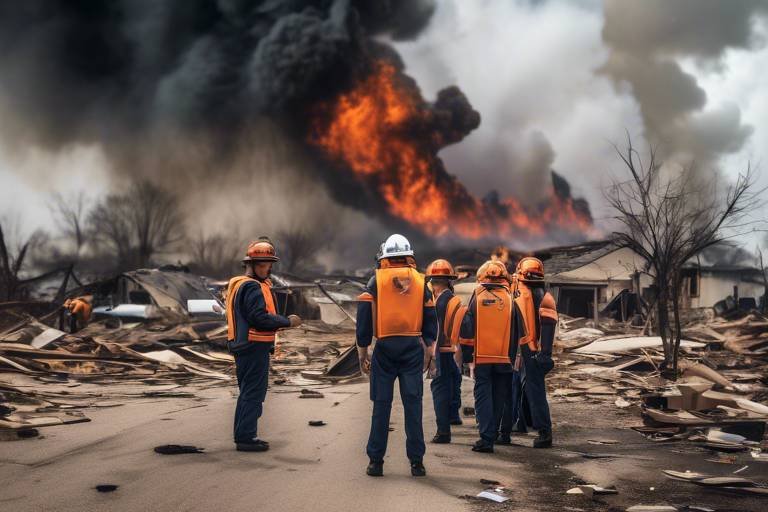The Role of Technology in Crisis Communication
In today's fast-paced world, the role of technology in crisis communication cannot be overstated. When emergencies arise, the ability to communicate effectively can mean the difference between chaos and order. Technology has revolutionized how organizations respond to crises, enabling them to disseminate information quickly, engage with stakeholders, and maintain a level of transparency that was previously unattainable. Imagine a scenario where a natural disaster strikes; the clock is ticking, and every second counts. Here, technology serves as the lifeline that connects organizations to their audiences, providing timely updates and critical information that can alleviate panic and misinformation.
One of the most significant transformations brought about by technology is the shift towards real-time communication. This capability allows organizations to issue immediate updates, ensuring that stakeholders are informed about the situation as it unfolds. For instance, during a public health crisis, real-time updates can help dispel rumors and clarify misinformation, allowing the public to make informed decisions. The immediacy of technology not only enhances the organization's credibility but also fosters a sense of trust among its audience.
Moreover, the advent of social media has introduced a new dimension to crisis communication. Platforms like Twitter, Facebook, and Instagram are not just social networking sites; they are powerful tools for organizations to share information rapidly and engage with their communities. During a crisis, these platforms allow for the dissemination of essential updates, safety tips, and resources, all while enabling organizations to interact directly with the public. This two-way communication fosters a sense of community and support, which is vital during challenging times.
However, effective crisis communication goes beyond just sharing information; it also involves building trust through transparency. Organizations must communicate openly and honestly about the situation at hand. This transparency can be achieved by providing regular updates, acknowledging uncertainties, and being upfront about the steps being taken to address the crisis. When stakeholders feel informed and included in the conversation, their trust in the organization strengthens, which is crucial during times of uncertainty.
Visual content plays a pivotal role in enhancing message clarity during crises. Infographics, videos, and images can convey complex information quickly and engagingly. For example, an infographic detailing safety protocols during a natural disaster can be more effective than a lengthy text document. Visuals can cut through the noise, making it easier for audiences to grasp essential information rapidly. This is especially important in crises where every second counts and clarity is paramount.
Engaging with the audience during a crisis is another critical aspect of effective communication. Organizations should actively monitor social media channels to respond to concerns and questions promptly. This engagement not only addresses public sentiment but also shows that the organization values its audience's input. Best practices for maintaining dialogue include acknowledging comments, providing timely responses, and using feedback to improve communication strategies.
In conclusion, technology has fundamentally transformed the landscape of crisis communication. From real-time updates to social media engagement and visual content, the tools available today empower organizations to respond effectively and maintain trust with their stakeholders. As we continue to navigate an increasingly complex world, embracing these technological advancements will be essential for effective crisis management.
- What is crisis communication? Crisis communication refers to the strategies and processes organizations use to communicate with stakeholders during an emergency or crisis situation.
- How does technology enhance crisis communication? Technology enhances crisis communication by enabling real-time updates, facilitating engagement through social media, and improving the clarity of information through visual content.
- Why is transparency important during a crisis? Transparency fosters trust among stakeholders, helping to mitigate panic and misinformation while reinforcing an organization's credibility.
- What role do social media platforms play in crisis communication? Social media platforms serve as vital channels for rapid information sharing, community engagement, and two-way communication between organizations and the public during crises.

The Importance of Real-Time Communication
In today's fast-paced world, real-time communication has become an indispensable tool during crises. Imagine being in a situation where every second counts—whether it's a natural disaster, a public health emergency, or a corporate crisis. The ability to provide immediate updates can make a significant difference in how stakeholders respond. Organizations that can swiftly disseminate information not only keep their audience informed but also help mitigate panic and misinformation. This is crucial because, in the absence of timely information, rumors can spread like wildfire, leading to chaos and confusion.
During a crisis, stakeholders look to organizations for guidance and clarity. Real-time communication allows these organizations to maintain transparency, which is vital for building trust. When people feel informed, they are less likely to jump to conclusions or panic. Moreover, timely updates can help to reassure the public that the situation is being handled effectively. Consider this: if a company is facing a product recall, providing real-time updates about the steps being taken can prevent customers from feeling abandoned or misled. Instead, they feel engaged and valued, which is essential for maintaining a positive relationship.
To illustrate the impact of real-time communication, let’s consider a few key components:
| Component | Impact |
|---|---|
| Immediate Updates | Reduces uncertainty and panic among stakeholders. |
| Transparency | Builds trust and credibility during critical times. |
| Engagement | Encourages dialogue and feedback, enhancing community support. |
Moreover, real-time communication can be facilitated through various channels, including social media, mobile apps, and SMS alerts. Each of these platforms offers unique advantages that can be leveraged to reach different audiences effectively. For example, social media allows for rapid dissemination and engagement, while SMS alerts can ensure that critical messages reach individuals who may not have internet access at the moment. The key is to choose the right mix of communication channels to ensure that information flows seamlessly.
In conclusion, the importance of real-time communication during crises cannot be overstated. It empowers organizations to act swiftly, keeps stakeholders informed, and fosters trust through transparency. By embracing technology and adopting effective communication strategies, organizations can navigate crises more effectively, ensuring that they emerge stronger and more resilient.

Social Media as a Crisis Tool
In today's fast-paced world, social media has emerged as a powerful ally during crises. Organizations are increasingly turning to platforms like Twitter, Facebook, and Instagram to disseminate information swiftly and engage with their communities. The beauty of social media lies in its real-time capabilities, allowing organizations to share updates almost instantaneously. Imagine a scenario where a natural disaster strikes; traditional media outlets may take time to report, but social media can relay critical information to thousands within seconds. This immediacy not only keeps stakeholders informed but also mitigates the spread of misinformation that often accompanies emergencies.
One of the key advantages of using social media in crisis communication is the ability to foster community engagement. During a crisis, people often turn to social media not just for information but also for support and connection. Organizations can leverage this by actively engaging with their audience, responding to queries, and providing reassurance. For instance, a simple acknowledgment of concerns can go a long way in building trust. By utilizing features such as live videos or stories, organizations can provide updates and address public sentiment in a more personal and relatable way.
Moreover, social media serves as a platform for crowdsourcing information. During emergencies, organizations can encourage users to share their experiences, photos, and updates. This not only enriches the organization's understanding of the situation but also empowers the community to contribute to the collective knowledge. For example, during a wildfire, residents can share real-time updates about affected areas, helping others to stay safe. However, it’s crucial for organizations to monitor these contributions closely to filter out any misleading information.
To effectively utilize social media as a crisis tool, organizations should consider the following strategies:
- Establish a Crisis Communication Plan: Before a crisis occurs, having a well-defined plan that outlines how social media will be used is essential. This plan should detail which platforms to use, key messages, and designated spokespersons.
- Monitor Social Media Channels: Keeping an eye on social media conversations can provide valuable insights into public sentiment and emerging issues. Tools like sentiment analysis can help organizations gauge how their messages are being received.
- Use Hashtags Wisely: Creating a specific hashtag for a crisis can help consolidate information and make it easier for stakeholders to find updates.
In conclusion, social media is not just a tool for sharing information; it is a vital component of crisis communication that allows organizations to connect with their audiences in meaningful ways. By embracing this technology, organizations can enhance their responsiveness, foster trust, and ultimately navigate crises more effectively.
Q: How can organizations prepare their social media strategy for a crisis?
A: Organizations should develop a comprehensive crisis communication plan that includes guidelines for social media use, designates roles and responsibilities, and outlines key messages to be communicated during a crisis.
Q: What are some common mistakes organizations make on social media during a crisis?
A: Some common mistakes include failing to monitor social media channels, not responding to inquiries promptly, and spreading unverified information. It's crucial to maintain a proactive and transparent approach.
Q: How can organizations measure the effectiveness of their social media communication during a crisis?
A: Organizations can use metrics such as engagement rates, reach, and sentiment analysis to evaluate the effectiveness of their communication strategies. Analyzing these metrics can help refine future approaches.

Building Trust Through Transparency
In the chaotic landscape of a crisis, where uncertainty reigns and fear can spread like wildfire, trust becomes the cornerstone of effective communication. Organizations that prioritize transparency during such tumultuous times can significantly bolster their credibility and foster a sense of security among stakeholders. Imagine being in a dark room, unsure of what lies ahead; now, think of a light being switched on, illuminating the path forward. That’s what transparency does—it lights the way, allowing everyone to see the full picture.
When a crisis strikes, stakeholders—be it employees, customers, or the general public—hunger for information. They want to know what happened, what is being done about it, and how it affects them. By openly sharing details, organizations can mitigate the spread of misinformation, which often thrives in the shadows of uncertainty. For instance, consider the following approaches:
- Regular Updates: Providing consistent updates helps keep everyone informed, reducing anxiety and speculation.
- Honesty About Challenges: Acknowledging difficulties and setbacks during a crisis shows that an organization is not only aware of the situation but is also actively working towards a solution.
- Encouraging Feedback: Inviting stakeholders to voice their concerns can create a two-way dialogue, making them feel valued and heard.
Moreover, transparency is not just about the information shared but also about the manner in which it is communicated. Using clear, straightforward language devoid of jargon can enhance understanding and engagement. For example, rather than stating, “Our systems have encountered a malfunction,” a more transparent approach would be, “We experienced a technical issue that temporarily affected our services. Here’s what we are doing to fix it.” This kind of clarity reassures stakeholders that the organization is in control and taking action.
Additionally, leveraging multiple communication channels can enhance transparency. Whether it’s through social media, email newsletters, or press releases, organizations should ensure that information is accessible to everyone. A table summarizing the various channels and their effectiveness can be useful:
| Communication Channel | Effectiveness | Best Use Case |
|---|---|---|
| Social Media | High | Real-time updates and engagement |
| Email Newsletters | Medium | Detailed information and updates |
| Press Releases | Medium | Formal announcements to the media |
| Website Updates | High | Centralized information hub |
Ultimately, building trust through transparency requires a commitment to open communication and a willingness to be vulnerable. Organizations that embrace this approach not only navigate crises more effectively but also emerge stronger and more resilient. When stakeholders feel informed and involved, they are more likely to stand by the organization, turning a potential crisis into an opportunity for growth and strengthened relationships.
Q1: Why is transparency important during a crisis?
Transparency is crucial as it helps mitigate misinformation and builds trust among stakeholders, ensuring they feel informed and secure.
Q2: How can organizations ensure they are being transparent?
Organizations can be transparent by providing regular updates, using clear language, and encouraging feedback from stakeholders.
Q3: What are some effective communication channels for crisis transparency?
Effective channels include social media for real-time updates, email newsletters for detailed information, and press releases for formal announcements.

Utilizing Visual Content
In today's fast-paced world, where information overload is the norm, visual content has emerged as a powerful tool in crisis communication. Imagine trying to explain a complex situation using only text; it can be overwhelming and often leads to misunderstandings. However, when you incorporate visuals like infographics, charts, and videos, you transform the way people absorb information. Visuals can simplify complex data, making it easier for stakeholders to grasp critical updates quickly and effectively.
During a crisis, time is of the essence. People want to understand what is happening, why it matters, and what actions they should take. This is where visual content truly shines. For instance, an infographic can succinctly outline the steps an organization is taking in response to a crisis, providing clarity and reassurance to the public. Furthermore, visuals can evoke emotions, drawing people in and fostering a deeper connection with the message being conveyed.
Consider a scenario where a natural disaster strikes. An organization might use a combination of social media posts featuring videos of relief efforts alongside infographics that show how to stay safe. This multi-faceted approach not only informs but also engages the audience, making them feel a part of the solution. By utilizing visual content, organizations can effectively convey urgency and importance while maintaining a sense of calm and order.
Moreover, the effectiveness of visual content in crisis communication is supported by data. Research shows that people are more likely to remember information presented visually than text alone. According to studies, visuals can increase retention rates by up to 65%. This means that during a crisis, organizations that leverage visual content are not only enhancing their communication but also ensuring that their messages stick with the audience.
To maximize the impact of visual content, organizations should consider the following strategies:
- Consistency: Ensure that all visuals align with the organization's branding and messaging.
- Clarity: Use simple, clear designs that communicate the message without unnecessary clutter.
- Accessibility: Make sure that visuals are accessible to all audiences, including those with disabilities.
In conclusion, utilizing visual content in crisis communication is not just a trend; it's a necessity. By effectively integrating visuals into their communication strategies, organizations can enhance understanding, foster trust, and ultimately guide their stakeholders through challenging times with clarity and compassion.
- Why is visual content important in crisis communication? Visual content helps simplify complex information, making it easier for audiences to understand critical updates quickly.
- What types of visual content are most effective? Infographics, videos, and charts are particularly effective as they convey information succinctly and engagingly.
- How can organizations ensure their visual content is accessible? By following accessibility guidelines, using alt text for images, and ensuring designs are clear and simple.

Engaging with the Audience
In the chaotic whirlpool of a crisis, is not just a nice-to-have; it's a lifeline. Organizations must recognize that their stakeholders are not merely passive recipients of information; they are active participants in the narrative. When a crisis strikes, the public turns to social media platforms, websites, and mobile apps to seek answers, express concerns, and share their experiences. This is where effective engagement becomes crucial. By fostering an open dialogue, organizations can not only address immediate concerns but also build a sense of community and trust.
Imagine being in a crowded room where everyone is talking, and you're the only one not listening. That's what it feels like for the audience when organizations fail to engage. To avoid this, organizations should adopt a proactive approach. This means not just broadcasting information but actively listening to the audience's feedback and responding in real-time. Here are some effective strategies:
- Monitor Social Media: Use social media monitoring tools to track mentions and sentiments. This helps organizations understand public perception and respond accordingly.
- Respond Promptly: Quick responses to questions and concerns can significantly reduce anxiety and misinformation. Acknowledging queries makes the audience feel valued.
- Encourage User-Generated Content: Invite stakeholders to share their experiences or thoughts. This not only enriches the conversation but also makes the audience feel involved.
Moreover, organizations should consider hosting live Q&A sessions. These sessions can be conducted via platforms like Facebook Live or Instagram Stories, allowing stakeholders to ask questions directly. This not only provides immediate answers but also showcases the organization's commitment to transparency. Think of it as a virtual town hall meeting where everyone has a voice.
Additionally, utilizing chatbots on websites and social media can enhance engagement. Chatbots can provide immediate responses to frequently asked questions, ensuring that stakeholders receive timely information even outside regular hours. This 24/7 availability can be a game-changer during a crisis when information is paramount.
Lastly, organizations should never underestimate the power of empathy in communication. Acknowledging the emotional toll a crisis can take on individuals can help bridge the gap between the organization and its audience. Phrases like “We understand how you feel” or “Your concerns are valid” can go a long way in fostering trust and connection.
In conclusion, engaging with the audience during a crisis is about more than just delivering messages; it's about creating a relationship built on trust, transparency, and mutual respect. By actively listening and responding, organizations can navigate the turbulent waters of crisis communication more effectively, ensuring that their stakeholders feel heard and valued.
- Why is audience engagement important during a crisis?
Engaging with the audience helps to build trust and ensure that accurate information is disseminated quickly, which can mitigate panic and misinformation. - What tools can organizations use for audience engagement?
Organizations can use social media platforms, chatbots, and monitoring tools to facilitate engagement and respond to audience concerns in real-time. - How can organizations ensure they are listening to their audience?
By actively monitoring social media mentions, conducting surveys, and encouraging feedback, organizations can stay attuned to the needs and sentiments of their audience.

Mobile Technology and Crisis Response
In today's fast-paced world, mobile technology plays a pivotal role in crisis response, acting as a lifeline for organizations aiming to communicate swiftly and effectively. Imagine a situation where every second counts—natural disasters, public health emergencies, or security threats. In these moments, the ability to reach stakeholders instantly can make all the difference. Mobile devices, equipped with apps and SMS capabilities, enable organizations to disseminate critical information without delay, ensuring that everyone stays informed and safe.
One of the most significant advantages of mobile technology is its accessibility. With billions of people carrying smartphones, organizations can tap into a vast network to share important updates. For instance, during a crisis, organizations can send out emergency alerts via SMS that provide real-time information on evacuation routes, safety procedures, or health advisories. This immediate access to information can help mitigate panic and confusion among the public, allowing individuals to make informed decisions quickly.
Moreover, mobile technology allows for two-way communication. Organizations can not only broadcast messages but also receive feedback and inquiries from the public. This engagement is crucial during a crisis, as it helps address concerns and questions that may arise. For example, a local government might use a mobile app to facilitate dialogue with citizens, allowing them to report issues or seek assistance. This interaction fosters a sense of community and reassurance, showing that the organization is actively listening and responding to the needs of its stakeholders.
To illustrate the impact of mobile technology in crisis response, consider the following table that highlights key tools and their functionalities:
| Tool | Functionality | Benefits |
|---|---|---|
| Mobile Apps | Provide real-time updates and resources | Enhanced accessibility and user engagement |
| SMS Alerts | Instant notifications for emergencies | Quick dissemination of critical information |
| Social Media Integration | Share updates and engage with the community | Broader reach and increased visibility |
In addition to these tools, organizations can leverage mobile technology to conduct training and simulations, preparing their teams for effective crisis management. By utilizing mobile platforms for drills, organizations can ensure that their personnel are well-versed in emergency protocols, ultimately enhancing their response capabilities when a real crisis occurs.
In summary, mobile technology is not just a convenience; it is an essential component of modern crisis response strategies. By harnessing the power of mobile devices, organizations can communicate effectively, engage with their audiences, and ultimately save lives during emergencies. As we continue to advance technologically, the integration of mobile solutions in crisis communication will undoubtedly evolve, leading to even more innovative strategies for managing crises.
- How can organizations ensure their mobile alerts reach everyone? Organizations should encourage individuals to opt-in for alerts and provide clear instructions on how to sign up for SMS notifications and download relevant apps.
- What types of information should be shared through mobile technology during a crisis? Critical information such as safety instructions, evacuation routes, and health advisories should be prioritized to ensure public safety.
- How can organizations measure the effectiveness of their mobile communication during crises? Organizations can track engagement metrics, such as the number of alerts received and responses to SMS messages, to evaluate their communication strategies.

Data Analytics for Crisis Management
In the fast-paced world we live in, crises can emerge without warning, leaving organizations scrambling to respond effectively. This is where data analytics comes into play, acting as a lighthouse guiding organizations through turbulent waters. By harnessing the power of data, organizations can not only predict potential crises but also assess their impact and refine their communication strategies. Imagine having a crystal ball that allows you to foresee challenges before they even arise—this is the transformative potential of data analytics in crisis management.
Data analytics involves collecting, processing, and analyzing vast amounts of data to derive actionable insights. During a crisis, organizations can leverage data from various sources, such as social media, news outlets, and internal reports, to gauge public sentiment and identify emerging trends. For instance, if an organization notices a spike in negative social media mentions, it can quickly pivot its communication strategy to address the concerns raised by stakeholders. This proactive approach not only mitigates the effects of misinformation but also demonstrates a commitment to transparency and engagement.
Moreover, data analytics can help organizations evaluate their crisis response effectiveness in real time. By utilizing key performance indicators (KPIs), organizations can track metrics such as response time, audience reach, and engagement levels. This allows them to make data-driven adjustments to their strategies on the fly. For example, if an organization finds that its initial messaging did not resonate with its audience, it can quickly adapt and reissue a more compelling communication. The ability to pivot based on real-time data is crucial in maintaining trust and credibility during a crisis.
To illustrate the impact of data analytics on crisis management, consider the following table that outlines some key benefits:
| Benefit | Description |
|---|---|
| Predictive Insights | Data analytics helps organizations anticipate potential crises by identifying patterns and trends. |
| Real-Time Monitoring | Organizations can track social media and news coverage to gauge public sentiment and react swiftly. |
| Performance Evaluation | KPIs allow organizations to assess the effectiveness of their crisis communication strategies. |
| Enhanced Decision-Making | Data-driven insights enable leaders to make informed decisions during high-pressure situations. |
In conclusion, the integration of data analytics into crisis management is not just a luxury; it is a necessity. As organizations navigate the complexities of modern crises, those that leverage data will not only survive but thrive. By embracing this analytical approach, organizations can enhance their preparedness, respond more effectively, and ultimately safeguard their reputation in the eyes of their stakeholders.
- What is data analytics in crisis management?
Data analytics in crisis management refers to the process of collecting and analyzing data to gain insights that can help organizations predict, manage, and respond to crises effectively. - How can data analytics predict crises?
By analyzing historical data, social media trends, and other relevant information, organizations can identify patterns that may signal an impending crisis. - What tools are commonly used for data analytics?
Common tools include Google Analytics, social media monitoring platforms, and specialized crisis management software that can aggregate and analyze data from multiple sources. - How can organizations measure the effectiveness of their crisis communication?
Organizations can measure effectiveness through KPIs such as response time, engagement rates, and audience sentiment analysis.

Measuring Communication Effectiveness
When it comes to crisis communication, understanding how effective your messaging is can be the difference between chaos and calm. It's not just about sending out information; it's about ensuring that information is received, understood, and acted upon. So, how do organizations measure the effectiveness of their communication during a crisis? The answer lies in a combination of metrics, feedback mechanisms, and data analysis.
First and foremost, organizations should establish clear objectives for their communication efforts. What do they want to achieve? Is it to inform, reassure, or perhaps mobilize action? Once these goals are set, specific metrics can be developed to gauge success. For instance, tracking the number of social media shares, likes, and comments can provide insight into how well the message resonates with the audience. Additionally, monitoring website traffic during a crisis can reveal how many people are seeking information and which messages are driving that traffic.
Another critical aspect of measuring communication effectiveness is gathering audience feedback. This can be achieved through surveys or polls distributed via email, social media, or even SMS. Asking stakeholders about their understanding of the situation and the clarity of the information provided can yield invaluable insights. For instance, organizations might ask:
- Did you find the information clear and concise?
- Were your concerns addressed?
- How would you rate our response time?
These questions not only help organizations assess their communication strategies but also demonstrate a commitment to transparency and improvement. By actively seeking feedback, organizations can build trust and show that they value their stakeholders' opinions.
Furthermore, leveraging data analytics can significantly enhance the measurement process. Advanced analytics tools can track engagement metrics in real-time, offering a live snapshot of how the audience is responding. For example, organizations can analyze sentiment on social media to understand public perception—are people feeling reassured or anxious? This kind of analysis can guide future communication efforts, allowing organizations to pivot their strategies based on real-time feedback.
To put this into perspective, consider a hypothetical scenario where a company faces a public relations crisis. By utilizing tools like Google Analytics and social media insights, they can compile data into a comprehensive report:
| Metric | Before Crisis | During Crisis | After Crisis |
|---|---|---|---|
| Website Traffic | 1,000 visits | 5,000 visits | 2,000 visits |
| Social Media Engagement | 100 interactions | 1,000 interactions | 300 interactions |
| Survey Feedback Score | N/A | 3.5/5 | 4.5/5 |
This table illustrates how communication efforts can shift audience behavior. Notice the spike in website traffic and social media engagement during the crisis. Analyzing this data helps organizations understand what worked, what didn’t, and how they can improve moving forward.
In conclusion, measuring communication effectiveness during a crisis is not just about collecting numbers; it’s about understanding the story those numbers tell. By setting clear objectives, gathering audience feedback, and utilizing data analytics, organizations can refine their communication strategies, ensuring they are better prepared for future challenges. After all, in the world of crisis management, knowledge is power, and the ability to adapt based on feedback can make all the difference.
Q1: Why is measuring communication effectiveness important during a crisis?
A1: Measuring communication effectiveness helps organizations understand how well their messages are being received and allows them to adjust their strategies to better meet the needs of their audience.
Q2: What metrics should organizations focus on?
A2: Key metrics include website traffic, social media engagement, audience feedback scores, and response times. These metrics provide insights into the reach and impact of communication efforts.
Q3: How can organizations gather audience feedback?
A3: Organizations can use surveys, polls, and social media interactions to gather feedback from their audience, helping them assess the clarity and effectiveness of their communication.

Future Trends in Crisis Communication
The landscape of crisis communication is constantly evolving, driven by advancements in technology and changing consumer behaviors. As we look to the future, several key trends are emerging that will shape how organizations communicate during crises. One of the most significant trends is the rise of artificial intelligence (AI) and machine learning. These technologies can analyze vast amounts of data in real-time, helping organizations anticipate potential crises before they escalate. Imagine having a digital assistant that can sift through social media chatter, news articles, and public sentiment to identify emerging issues—this is no longer a distant dream but a rapidly approaching reality.
Another notable trend is the increasing importance of video content in crisis communication. In a world where attention spans are dwindling, video has proven to be an effective medium for conveying messages quickly and engagingly. Organizations are likely to invest more in creating high-quality video content that can be shared across various platforms during a crisis. This could include live updates, behind-the-scenes footage of response efforts, or even testimonials from affected individuals, making the communication more relatable and human.
Additionally, the integration of augmented reality (AR) and virtual reality (VR) into crisis communication strategies is on the horizon. These technologies can provide immersive experiences that allow stakeholders to understand the situation better. For instance, a VR simulation could help users visualize the impact of a natural disaster, fostering empathy and understanding. As organizations become more adept at using these technologies, they will likely enhance their ability to communicate complex situations effectively.
Furthermore, the role of data analytics will continue to grow. Organizations will increasingly rely on data-driven insights to tailor their communication strategies. By analyzing past crises and their communication responses, organizations can identify what worked and what didn’t, allowing them to refine their approaches for future incidents. This proactive stance is essential in a world where public perception can shift rapidly based on the effectiveness of communication during crises.
Lastly, the emphasis on community engagement will become more pronounced. As organizations recognize the value of building relationships with their stakeholders, they will prioritize open channels of communication. This means not only broadcasting messages but also creating opportunities for dialogue. Social media platforms will play a crucial role in this, allowing organizations to interact with their audience in real-time, address concerns, and gather feedback. In essence, the future of crisis communication will be characterized by a more collaborative and transparent approach.
- What is the role of technology in crisis communication? Technology facilitates rapid information dissemination, enhances stakeholder engagement, and improves responsiveness during crises.
- How can organizations prepare for future crises? By investing in data analytics, AI, and community engagement strategies, organizations can better anticipate and respond to crises.
- Why is transparency important during a crisis? Transparency fosters trust among stakeholders, which is crucial for maintaining credibility during uncertain times.
- What types of content are most effective in crisis communication? Visual content, such as infographics and videos, can effectively convey complex information and engage audiences.
Frequently Asked Questions
- What is the role of technology in crisis communication?
Technology plays a transformative role in crisis communication by enhancing responsiveness, improving information dissemination, and fostering stakeholder engagement. It allows organizations to communicate quickly and effectively during emergencies, ensuring that accurate information reaches those who need it most.
- Why is real-time communication crucial during crises?
Real-time communication is essential during crises because it enables organizations to provide immediate updates. This timely information helps mitigate panic and prevents the spread of misinformation, allowing stakeholders to stay informed and make better decisions during critical situations.
- How do social media platforms aid in crisis communication?
Social media platforms are vital tools in crisis communication as they facilitate rapid information sharing and community engagement. Organizations can use these platforms to quickly disseminate updates, respond to public inquiries, and create a dialogue with affected communities, thereby enhancing trust and transparency.
- What strategies can organizations use to build trust during a crisis?
To build trust during a crisis, organizations should focus on transparency by communicating openly and honestly. This includes sharing both good and bad news, providing regular updates, and addressing concerns directly. By doing so, they reinforce their credibility and strengthen their relationship with stakeholders.
- How effective is visual content in crisis communication?
Visual content, such as infographics and videos, significantly enhances message clarity during crises. It allows organizations to convey complex information quickly and engagingly, making it easier for stakeholders to understand critical updates and instructions.
- What role does mobile technology play in crisis response?
Mobile technology is crucial for crisis response as it enables organizations to reach stakeholders instantly. Mobile apps and SMS alerts are effective tools for disseminating critical information, ensuring that updates are delivered directly to individuals' devices when they need them the most.
- How can data analytics improve crisis management?
Data analytics enhances crisis management by enabling organizations to predict potential crises, assess their impact, and refine communication strategies. By analyzing data trends, organizations can make informed decisions and improve their preparedness for future emergencies.
- What metrics should organizations use to measure communication effectiveness?
Organizations can measure communication effectiveness through various metrics, including engagement rates on social media, feedback from stakeholders, and the speed of information dissemination. Tools like surveys and analytics platforms can provide insights into how well communication strategies are performing.
- What future trends should we expect in crisis communication?
The landscape of crisis communication is continually evolving, with emerging technologies such as AI and machine learning expected to play significant roles. Future trends may include more personalized communication strategies, enhanced data analytics capabilities, and increased reliance on mobile technology to ensure organizations remain prepared and adaptable during crises.



















